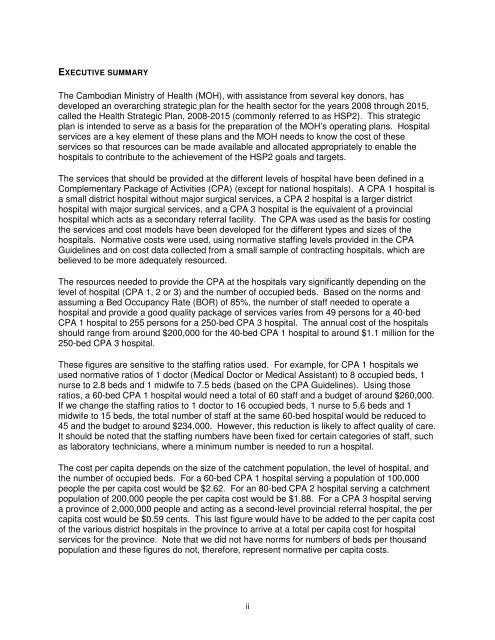Cost Projections for the Complementary Package of Activities - basics
Cost Projections for the Complementary Package of Activities - basics
Cost Projections for the Complementary Package of Activities - basics
You also want an ePaper? Increase the reach of your titles
YUMPU automatically turns print PDFs into web optimized ePapers that Google loves.
EXECUTIVE SUMMARYThe Cambodian Ministry <strong>of</strong> Health (MOH), with assistance from several key donors, hasdeveloped an overarching strategic plan <strong>for</strong> <strong>the</strong> health sector <strong>for</strong> <strong>the</strong> years 2008 through 2015,called <strong>the</strong> Health Strategic Plan, 2008-2015 (commonly referred to as HSP2). This strategicplan is intended to serve as a basis <strong>for</strong> <strong>the</strong> preparation <strong>of</strong> <strong>the</strong> MOH’s operating plans. Hospitalservices are a key element <strong>of</strong> <strong>the</strong>se plans and <strong>the</strong> MOH needs to know <strong>the</strong> cost <strong>of</strong> <strong>the</strong>seservices so that resources can be made available and allocated appropriately to enable <strong>the</strong>hospitals to contribute to <strong>the</strong> achievement <strong>of</strong> <strong>the</strong> HSP2 goals and targets.The services that should be provided at <strong>the</strong> different levels <strong>of</strong> hospital have been defined in a<strong>Complementary</strong> <strong>Package</strong> <strong>of</strong> <strong>Activities</strong> (CPA) (except <strong>for</strong> national hospitals). A CPA 1 hospital isa small district hospital without major surgical services, a CPA 2 hospital is a larger districthospital with major surgical services, and a CPA 3 hospital is <strong>the</strong> equivalent <strong>of</strong> a provincialhospital which acts as a secondary referral facility. The CPA was used as <strong>the</strong> basis <strong>for</strong> costing<strong>the</strong> services and cost models have been developed <strong>for</strong> <strong>the</strong> different types and sizes <strong>of</strong> <strong>the</strong>hospitals. Normative costs were used, using normative staffing levels provided in <strong>the</strong> CPAGuidelines and on cost data collected from a small sample <strong>of</strong> contracting hospitals, which arebelieved to be more adequately resourced.The resources needed to provide <strong>the</strong> CPA at <strong>the</strong> hospitals vary significantly depending on <strong>the</strong>level <strong>of</strong> hospital (CPA 1, 2 or 3) and <strong>the</strong> number <strong>of</strong> occupied beds. Based on <strong>the</strong> norms andassuming a Bed Occupancy Rate (BOR) <strong>of</strong> 85%, <strong>the</strong> number <strong>of</strong> staff needed to operate ahospital and provide a good quality package <strong>of</strong> services varies from 49 persons <strong>for</strong> a 40-bedCPA 1 hospital to 255 persons <strong>for</strong> a 250-bed CPA 3 hospital. The annual cost <strong>of</strong> <strong>the</strong> hospitalsshould range from around $200,000 <strong>for</strong> <strong>the</strong> 40-bed CPA 1 hospital to around $1.1 million <strong>for</strong> <strong>the</strong>250-bed CPA 3 hospital.These figures are sensitive to <strong>the</strong> staffing ratios used. For example, <strong>for</strong> CPA 1 hospitals weused normative ratios <strong>of</strong> 1 doctor (Medical Doctor or Medical Assistant) to 8 occupied beds, 1nurse to 2.8 beds and 1 midwife to 7.5 beds (based on <strong>the</strong> CPA Guidelines). Using thoseratios, a 60-bed CPA 1 hospital would need a total <strong>of</strong> 60 staff and a budget <strong>of</strong> around $260,000.If we change <strong>the</strong> staffing ratios to 1 doctor to 16 occupied beds, 1 nurse to 5.6 beds and 1midwife to 15 beds, <strong>the</strong> total number <strong>of</strong> staff at <strong>the</strong> same 60-bed hospital would be reduced to45 and <strong>the</strong> budget to around $234,000. However, this reduction is likely to affect quality <strong>of</strong> care.It should be noted that <strong>the</strong> staffing numbers have been fixed <strong>for</strong> certain categories <strong>of</strong> staff, suchas laboratory technicians, where a minimum number is needed to run a hospital.The cost per capita depends on <strong>the</strong> size <strong>of</strong> <strong>the</strong> catchment population, <strong>the</strong> level <strong>of</strong> hospital, and<strong>the</strong> number <strong>of</strong> occupied beds. For a 60-bed CPA 1 hospital serving a population <strong>of</strong> 100,000people <strong>the</strong> per capita cost would be $2.62. For an 80-bed CPA 2 hospital serving a catchmentpopulation <strong>of</strong> 200,000 people <strong>the</strong> per capita cost would be $1.88. For a CPA 3 hospital servinga province <strong>of</strong> 2,000,000 people and acting as a second-level provincial referral hospital, <strong>the</strong> percapita cost would be $0.59 cents. This last figure would have to be added to <strong>the</strong> per capita cost<strong>of</strong> <strong>the</strong> various district hospitals in <strong>the</strong> province to arrive at a total per capita cost <strong>for</strong> hospitalservices <strong>for</strong> <strong>the</strong> province. Note that we did not have norms <strong>for</strong> numbers <strong>of</strong> beds per thousandpopulation and <strong>the</strong>se figures do not, <strong>the</strong>re<strong>for</strong>e, represent normative per capita costs.ii
















